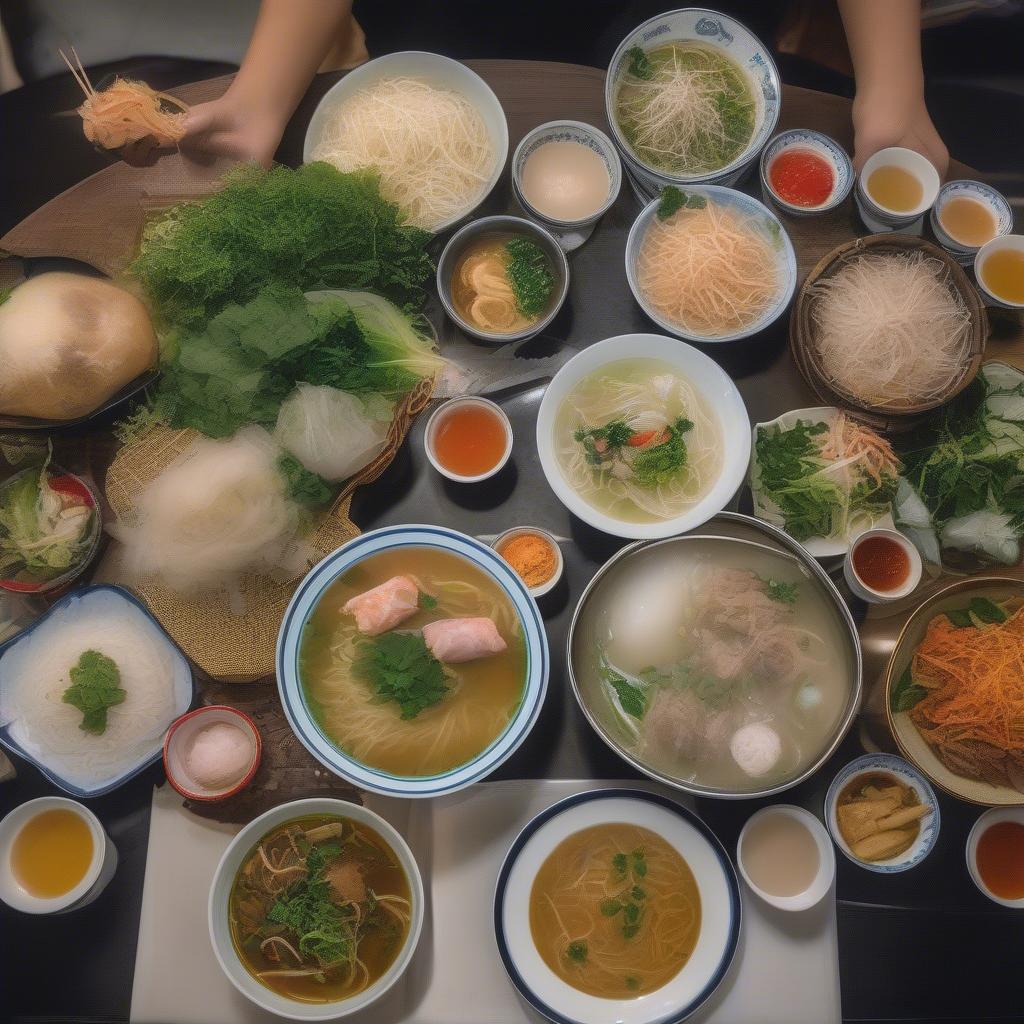
Pho, the aromatic and flavorful Vietnamese soup, has captivated taste buds worldwide. But amidst its global popularity, a question often arises: is pho truly Vietnamese? Let’s delve into the history of this beloved dish to uncover its origins and cultural significance.
The precise origin of pho is shrouded in a bit of mystery, a blend of culinary influences and historical shifts. While definitively pinpointing its “birth” is difficult, most food historians agree that pho emerged in the early 20th century in northern Vietnam, specifically around Hanoi and Nam Dinh. Its development is likely linked to a confluence of factors, including French colonialism and the existing culinary traditions of the region.
One theory suggests that the word “pho” is derived from the French word “feu,” referring to the French pot-au-feu, a beef stew. This theory posits that the French influence during the colonial period introduced the concept of beef broth to Vietnamese cuisine. Another perspective highlights the potential influence of Chinese immigrants, who may have brought with them noodle dishes and cooking techniques that contributed to the evolution of pho. The use of star anise and other spices, often associated with Chinese cuisine, lends credence to this idea.
Regardless of its exact origins, pho became a staple in northern Vietnam, particularly as a breakfast food. Vendors would carry their mobile pho stalls through the streets, filling the air with the enticing aroma of simmering broth. Over time, distinct regional variations emerged. Northern pho typically features a simpler broth, focusing on the pure flavors of beef and spices. As pho migrated south, it adopted new characteristics, with the addition of fresh herbs, bean sprouts, and a wider array of condiments like hoisin and sriracha sauce.
What makes pho distinctly Vietnamese, however, is the meticulous preparation and the delicate balance of flavors. The broth, the heart and soul of pho, is simmered for hours, often with charred onions and ginger, along with a blend of spices like star anise, cinnamon, cloves, and cardamom. The rice noodles, known as bánh phở, are soft and silky, perfectly complementing the rich broth. Thinly sliced beef, or sometimes chicken, is added to the bowl, along with fresh herbs like cilantro, basil, and onions.
Is the preparation of pho complex? Not necessarily. While achieving the perfect balance of flavors may require practice, the basic process involves simmering the broth, preparing the noodles, and adding the desired toppings. The beauty of pho lies in its versatility; it can be adapted to individual preferences with different cuts of meat, herbs, and spices.
What are the key ingredients that make pho so unique? The combination of star anise, cinnamon, and cloves creates a distinct aromatic profile that is characteristic of Vietnamese cuisine. The addition of fresh herbs and spices adds another layer of complexity to the flavor.
“Pho is more than just a soup; it’s a reflection of Vietnamese culture and history,” explains renowned food historian, Dr. Nguyen Thi Lan Anh. “The blending of flavors and ingredients tells a story of cultural exchange and adaptation.” Chef Pham Van Minh adds, “The secret to a truly delicious pho lies in the quality of the broth. It must be simmered slowly and patiently to extract the full depth of flavor.”
How has pho evolved over time? As pho gained popularity throughout Vietnam and beyond, regional variations emerged, incorporating local ingredients and preferences. From the addition of seafood in coastal regions to the use of different types of noodles, pho has demonstrated remarkable adaptability.
 Regional Variations of Vietnamese Pho: North vs. South
Regional Variations of Vietnamese Pho: North vs. South
In conclusion, while the precise origins of pho may be debated, its status as a quintessential Vietnamese dish is undeniable. Pho embodies the essence of Vietnamese cuisine – a harmonious blend of fresh ingredients, aromatic spices, and meticulous preparation. So, next time you savor a bowl of pho, remember its rich history and the cultural legacy it represents. Visit Com Com Restaurant at 183-185 Battersea Park Rd, London, or call 020 7720 9928 to experience the authentic taste of pho. We’re open daily from 12:00 PM to 10:00 PM, with delivery service available to bring the flavors of Vietnam straight to your door.
Is pho healthy? Generally, pho is a healthy and balanced meal, packed with protein, nutrients, and fresh herbs. However, the sodium content can be high, so moderation is key.
What are some common variations of pho? Aside from the regional variations, pho can also be made with chicken, seafood, or tofu for a vegetarian option.
Where can I find the best pho? While Hanoi is often considered the birthplace of pho, delicious pho can be found throughout Vietnam and in Vietnamese restaurants worldwide. Come to Com Com Restaurant for an authentic taste.
What is the cultural significance of pho? Pho is more than just a dish; it is a symbol of Vietnamese culinary heritage and a source of national pride.
How do I eat pho properly? Pho is traditionally eaten with chopsticks and a spoon. The chopsticks are used to pick up the noodles and meat, while the spoon is used to sip the broth.
What is the difference between northern and southern pho? Northern pho typically has a simpler, clearer broth, while southern pho often features a sweeter, richer broth with more herbs and toppings.
Why is pho so popular? Pho’s popularity stems from its delicious and comforting flavors, its versatility, and its affordability.
